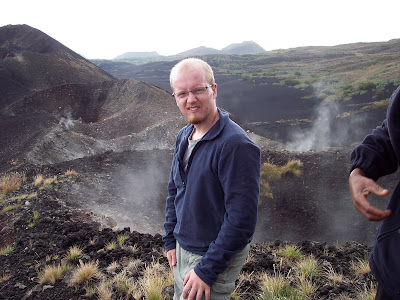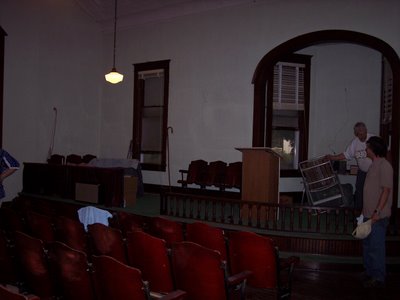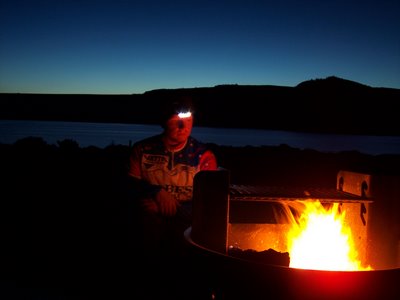Now, you would think that when you travel to a place like Cameroon, that your most memorable experience would be something like seeing a rare mountain gorilla or eating pig brains or something like that. Well, it turns out, that, for me, the most memorable and adventurous thing we have done so far is...take public transportation.
If you've read my previous posts, you understand that the buses, which are the primary means of transportation here are, how shall I put it delicately, not exactly up to Western standards of safety and comfort. Isaac and I had a taste of that the past couple of weeks on our rides in minibuses, and people and our guidebook warned us of the bad road conditions from Foumban to N'gaoundere, but nothing could really quite prepared us for the 36 HOUR ODYSSEY that we were to experience.
Our trusty (and now muddy) Lonely Planet guidebook said to budget a few days for the journey. In mind mind, I was thinking one long day to travel by bus from Foumban to Banyo, rest in a hotel for the night, then another long day from Banyo to N'gaoundere. The journey did take two days, but two days straight with no sleep.
We started by waking at 6 AM to meet our bus at 7 at the station. We've come to expect the late departure of buses at this point, but this time it was 6 hours late. After about 4 hours, we were getting a bit impatient, and were asking them why we weren't leaving. After all, we had the passengers, the loaded minibus, but...no driver. No one knew where he was. One of our fellow passengers chuckled at our impatience, and when we asked how long the trip would take he chuckled again and said something like, "It may take 12 hours, it may take 3 days. All we know is that we will get to Banyo. The road is very bad."
Well, finally, 6 hours later at 1 PM, the driver showed up, we all piled into the minibus, and off we went. You can see from the photos how much they pile on top of the bus, but what you cannot see is how much they pile inside. Since they had removed the last row of seats, we had "only" 4 rows left to stuff full of people, because the more they stuff in, the more money they earn. 1st row: Driver and 3 other men. 2nd row: 2 guys, 2 women, 1 child. 3rd row: Us (2 men), a woman, another guy and 2 kids. Last row: 5 women, 4 kids. Total: 9 guys, 8 women, 7 kids makes 24 people.
Now, look at the pictures of us (the red bus) getting ourselves unstuck from these mud pits, and imagine doing this over 20 times, for 16 hours (until 5 AM the next morning) some of the time in the rain and some in the dark, and you begin to get a picture of what this voyage was for us. The 1st part, at least.

At least there are two lanes

Tow ropes help


You also need to keep in mind that this isn't something out of the ordinary. These are relatively typical conditions for this road, and it is often much worse during the rainy season; another passenger, Fidelis, the man who was laughing at our impatience, said he once spent 3 days traveling the same stretch of road. This also isn't some obscure back road--it is the main road between these major cities.
Yet, as hellish as this seems, it was actually, in a strange way, actually pretty fun. I was so impressed by everyone's sense of humor. Whereas most of us soft Westerners would be cursing and perhaps crying, almost everyone was laughing and joking around. Everyone had to work together to rock, push, pull and will the bus out of the mudpit.
I was also blown away by how the women and kids just took it in stride. Another mud pit? 1 AM? OK? Just hop out of the van, walk past, and wait for it to get out. All of the kids in the car were young, under 5, and I rarely heard more than a whimper out of any of them.
We were not the only vehicle in this mess. There were dozens of others also stuck, including these huge delivery trucks, half of which were tipped over. It was a very circus-like atmosphere with people pushing and pulling vehicles, women and children selling food, the Cameroonians laughing at us for slipping in the mud. It doesn't get much more fun than this.
We finally arrive in Banyo, at 5 AM, 16 hours later. Our legs are splattered in mud, we haven't slept, and we've had nothing but bread and bananas to eat. Our plan had been to rest in Banyo for a night or two, but since the N'gaoundere bus left in an hour, we decided that we might as well just take it.
The other passengers waiting for the bus are also waiting there in the train station, sprawled out sleeping on benches.
At roughly 6 AM we start loading the next bus, and by 7, we're rolling to N'gaoundere. This time the road isn't as rough, but the bus is more uncomfortable. I think it maybe used to be a prison transport, because we all have to load in the back and there is a metal cage separating us passengers from the driver's compartment. All told, there are probably about 50 or 60 people packed into these extremely uncomfortable benches.
To make a very long story short, we arrive there after 11 hours, at 6 PM. The road isn't as bad as before, but that means there aren't as many chances to get out and stretch our legs. We made it to N'gaoundere, though, very tired.















 The Athleticlub TV lounge in Scott City, KS where I slept and survived the serial killer attack.
The Athleticlub TV lounge in Scott City, KS where I slept and survived the serial killer attack. My Puddle. Not the most attractive name for an RV park, but here in Kansas even puddles are exciting.
My Puddle. Not the most attractive name for an RV park, but here in Kansas even puddles are exciting.
















